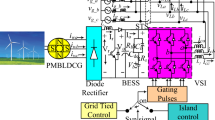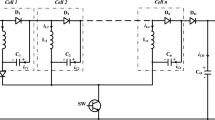Abstract
This paper deals with a power electronics topology that combines the features of both a boost converter and a SEPIC in a cascaded configuration using small wind turbines, to efficiently convert the variable and often low-voltage output of the turbine’s generator into a stable and usable form for charging batteries or feeding power to the grid. Its purpose is to efficiently convert the variable and often low-voltage electrical output generated by the small wind turbine into a stable and usable form of electrical energy. A specialized power electronics converter is needed as an interface for conditioning the generated power from the renewable energy source. The output power from a wind turbine is collected via a cascaded converter. The experimental data from the suggested system’s implementation in the smart energy laboratory demonstrate a sizable improvement over the current converter.







Similar content being viewed by others
Data Availability
There is no data availability in this paper.
Abbreviations
- SEPIC:
-
Single-ended primary inductor converter
- \(V_{{{\text{in}}}}\) :
-
Input voltage
- \(V_{{{\text{out}}}}\) :
-
Output voltage
- \(S_{n}\) :
-
Switches
- \(D_{n}\) :
-
Diodes
- \(C_{n}\) :
-
Capacitors
- \(C_{{{\text{out}}}}\) :
-
Output capacitor
- n :
-
Parameters number
- \(L_{n}\) :
-
Inductors
- CBSC:
-
Cascaded boost–SEPIC converter
- MPPT:
-
Maximum power point tracking
- PV:
-
Photo voltaic
- WT:
-
Wind turbine
- MICs:
-
Multi-input converters
- HFTs:
-
High-frequency transformer
References
S. Wagh, P.V. Walke, Review on wind-solar hybrid power system. Int. J. Res. Sci. Eng. 3(2), 71–76 (2017)
A. Wasonga, M. Saulo, V. Odhiambo, Solar-wind hybrid energy system for new engineering complex- technical university of Mombasa. Int. J. Energy Power Eng. 4, (2014)
T.R. Ayodele, A.A. Jimoh, J.L. Munda, J.T. Agee, Challenges of grid integration of wind power on power system grid integrity: a review. Int. J. Renew. Energy Res. 2(4), 618–626 (2012)
M. Kaliamoorthy, V. Rajasekaran, G. PraveenRaj, A novel single phase cascaded multilevel inverter for hybrid renewable energy sources, in International Conference on Advanced Computing and Communication Systems, (2015)
S. Bae, A. Kwasinski, Dynamic modeling and operation strategy for a microgrid with wind and photovoltaic resources. IEEE Trans. Smart Grid 3(4), 1867–1876 (2012)
B.G. Dobbs, P.L. Chapman, A multiple-input DC–DC converter topology. IEEE Power Electron. Lett. 1(1), 6–9 (2003)
J.C. Rosas-Caro, J.M. Ramirez, P.M. Garcia Vite, Novel DC-DC multilevel boost converter, in Proceedings of IEEE Power Electronics Specialists Conference, (2008)
G.R. Walker, P.C. Sernia, Cascaded DC–DC converter connection of photovoltaic modules. IEEE Trans. Power Electron. 19(4), 1130–1139 (2004)
I. Sefa, Ş. Ozdemir, Experimental study of interleaved MPPT converter for PV systems, in Proceedings of 35th Annual Conference of IEEE Industrial Electronics, (2009)
A. Kwasinski, Identification of feasible topologies for multiple-input dc–dc converters. IEEE Trans. Power Electron. 24(3), 856–861 (2009)
R. Tymerski, V. Vorperian, Generation and classification of PWM dc-to-dc converters. IEEE Trans. Aerosp. Electron. Syst. 24, (1988)
N. Holtsmark, H.J. Bahirat, M. Molinas, B.A. Mork, H.K. Hoidalen, An All-DC offshore wind farm with series-connected turbines: an alternative to the classical parallel AC model. Ind. Electron. IEEE Trans. 60(6), 2420–2428 (2013)
H. Krishnamoorthy, M. Daniel, J. Ramos-Ruiz, P. Enjeti, M. Liu, E. Aeloiza, Isolated AC-DC converter using medium frequency transformer for off-shore wind turbine DC collection grid. IEEE Trans. Ind. Electron. 64(11), 8939–8947 (2017)
G. Shi, J. Zhang, X. Cai, M. Zhu, L. Yao, Improved variable speed control of series-connected DC wind turbines for offshore wind power collection to HVDC system. IET Renew. Power Gener.Gener. 10(6), 843–851 (2016)
M. Johnson, D. Aliprantis, Analysis of series-DC offshore wind plants with aerodynamic wake effects. IEEE Trans. Sustain. Energy 8(4), 1706–1714 (2017)
D. Montesinos-Miracle, M. Massot-Campos, J. Bergas-Jane, S. Galceran-Arellano, A. Rufer, Design and control of a modular multilevel DC/DC converter for regenerative applications. IEEE Trans. Power Electron. 28(8), 3970–3979 (2013)
F. Zhang, F.Z. Peng, Z. Qian, Study of multilevel converter in DC-DC applications, in Proceedings IEEE 35th Annual Power Electronics Specialists Conference, vol 2, (2004)
A.C. Norões Maia, C.B. Jacobina, G. Arthur de Almeida Carlos, A new three-phase AC–DC–AC multilevel converter based on cascaded three-leg converters. IEEE Trans. Ind. Appl. 53(3), (2017)
G. Butti, J. Biela, Novel high efficiency multilevel DC-DC boost converter topologies and modulation strategies, in Proceedings of European Conference on Power Electronics and Applications (EPE, Birmingham, UK, 2011)
Y.E. Majeed, I. Ahmad, D. Habibi, A multiple-input cascaded DC-DC converter for very small wind turbines. IEEE Trans. Industr. Electron.Industr. Electron. 66(6), 4414–4423 (2018)
G.B. Hangaragi, R.P. Mandi, A hybrid model of solar – wind power generation system, in National Conference on Recent Advances in Control Strategies for Integration of Distributed Generation Sources to Grid and Control of Their Power Quality Issues, (2016)
S. Ssenyimba, N. Kiggundu, N. Banadda, Designing a solar and wind hybrid system for small-scale irrigation: a case study for Kalangala district in Uganda. Energy Sustain. Soc. 10, 1–18 (2020)
C.S. Nalamati, P. Samuel, R. Gupta, Distributed wind energy conversion system interface to the grid using cascaded multi-level converter. IETE J. Res. 64(2), 231–240 (2017)
Y. Sawle, S.C. Gupta, A. Kumar Bohre, PV-wind hybrid system: a review with case study. Cogent Eng. 3(1), 1189305 (2020)
P.K. Maroti, S. Padmanaban, M.S. Bhaskar, F. Blaabjerg, P. Siano, V. Fedak, V.K. Ramachandramurthy, A high gain modified SEPIC DC-to-DC boost converter for renewable energy applications, IEEE, (2017)
R. Kumari, M. Pandit, K.S. Sherpa, Modelling and comparison of conventional SEPIC converter with cascaded Boost-SEPIC converter. J. Inst. Eng. (India) Ser. B 102, 99–109 (2020)
N.K. Mishra, Z. Husain, Application of novel six-phase doubly fed induction generator for open phases through modeling and simulation. IETE J. Res. 69(6), 3916–3927 (2023)
Funding
The authors have not disclosed any funding.
Author information
Authors and Affiliations
Corresponding author
Ethics declarations
Conflict of interest
I certify, on behalf of all involved authors, that the work presented in this publication was not influenced by any known conflicting financial interests or personal ties. I hereby declare that none of the following relationships or financial interests might be viewed as potentially conflicting with one another.
Additional information
Publisher's Note
Springer Nature remains neutral with regard to jurisdictional claims in published maps and institutional affiliations.
Rights and permissions
Springer Nature or its licensor (e.g. a society or other partner) holds exclusive rights to this article under a publishing agreement with the author(s) or other rightsholder(s); author self-archiving of the accepted manuscript version of this article is solely governed by the terms of such publishing agreement and applicable law.
About this article
Cite this article
Kumari, R., Dahal, R., Pandit, M. et al. A Single-Switch High-Gain Cascaded Boost–SEPIC Converter Using Small Wind Turbine for Renewable Energy Applications. J. Inst. Eng. India Ser. B (2024). https://doi.org/10.1007/s40031-024-01061-8
Received:
Accepted:
Published:
DOI: https://doi.org/10.1007/s40031-024-01061-8




